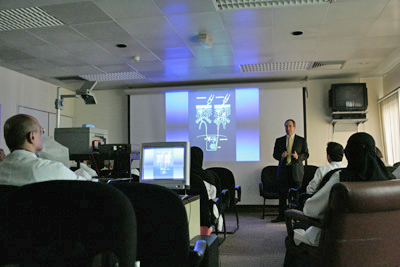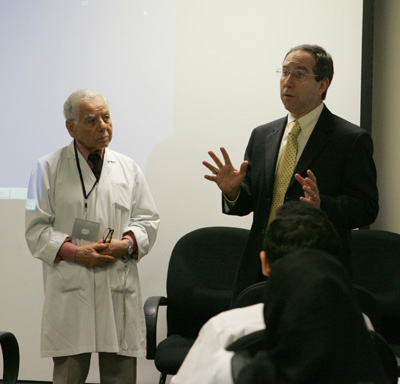Secrets of the skin

In Grand Rounds, Dr. Granstein presented recent advances in research
into the immunological function of the skin.
“One of the fun things about research is that every answer to a question leads to more questions,” observed Dr. Richard D. Granstein, interviewed during a visit to WCMC-Q in May.
Dr. Granstein, who is the George W. Hambrick Jr. Professor of Dermatology at Weill Cornell Medical College and Dermatologist-in-Chief at NewYork-Presbyterian Hospital, provided ample evidence of this truth when he explored some of the most up-to-date research in the specialty in Grand Rounds at Hamad Medical Corporation’s Rumeillah Hospital, May 18, and in an interview afterwards.
“Skin is a wonderful, complex organ,” he noted in his introduction to Grand Rounds on The Regulation of Langerhans Cell Function. Its many functions range from temperature regulation to protection from damage by external forces, but Dr. Granstein’s particular research interest is in its highly complex immunological role, and how outside factors may affect this.
Skin helps protect us by organizing and activating the immune system. Langerhans cells, which form a network in the epidermis or outer layer of skin, play an important part in this activity, by up-regulating the immune response to bacteria or viruses.
Discovering the skin’s secrets
The function of the cells, which were discovered by medical student Paul Langerhans in Germany, in 1868, remained something of a mystery for a hundred years until researchers began to uncover their secrets during the 1960s and ‘70s.
Experiments in the laboratory showed that Langerhans cells protect mice against growth of tumors when the Langerhans cells are both mature and genetically compatible with the host animal.
“Langerhans cells are the principal antigen-presenting cells of the epidermis,” Dr. Granstein explained. “They are critical in initiating immune responses and stimulating the immune system against something entering the skin.”
However, recent research suggests that immature Langerhans cells participate in down-regulating the immune response. Citing “very preliminary data” from Yale University, Dr. Granstein noted that this action may control the response, ensuring that once it has dealt with the invading organism, it ceases. In effect, by setting a limit to the response, the Langerhans cells maintain a balance in the immune system.

Dr. Granstein responds to questions from HMC physicians, with
consultant dermatologist Dr. Mohammed Mohie at left.
“This research has suggested that the cells may actually regulate immunity – not only stimulating it, but regulating the extent of it, perhaps even limiting the amount of immunity. This is a very exciting and somewhat unexpected development,” Dr. Granstein commented.
“It is an evolving area, and I think over the next few years, there will be a lot of research in trying to understand this,” he added.
When the balance is disturbed – as in disorders such as lupus erythematosus – an inappropriate immune reaction is directed against components of the skin and other organs. Why the reaction does not stop, but turns against normal tissue, is not fully understood. Dr. Granstein demonstrated that sunlight exacerbates the condition, and he suggested this may result from release of cytokines by skin cells in response to ultraviolet (UV) radiation.
The dangers of UV radiation
The role of UV rays in suppressing the immune system was explored further in relation to skin cancers. Dr. Granstein noted that experiments carried out in mice had shown that some UV-induced tumors stimulated the immune system to destroy them – so the question arose: why did the tumors arise in the first place?
Further research showed that UV radiation also has immunosuppressive qualities in these animals. It produces a cascade of events leading to failure to recognize and react to tumor cells. If this is also true for humans, then UV radiation may pose a double threat, by producing mutations in cells leading to uncontrolled growth and by causing suppression of the immune response.
The risk posed by skin cancers, particularly malignant melanomas, should be taken seriously, and Dr. Granstein’s department at Weill Cornell Medical College in New York City actively promotes screening for all types of skin cancer.
May was National Melanoma/Skin Cancer Detection and Prevention Month, and in free screening sessions offered at the Medical College in New York during the month, clinicians identified a number of cancers among some 200 people who came for free check-ups, Dr. Granstein reported.
There are both pre-malignant lesions and malignant skin cancers. With the most serious type, malignant melanoma, early identification is essential: “The key thing is early detection and surgical removal of the melanoma before it has metastasized,” Dr. Granstein said. His recommendation was to have screening annually, and more frequently where there is a personal or family history of skin cancer or other risk factors such as immunosuppression or large numbers of atypical-appearing moles.
As for prevention, Dr. Granstein’s advice was to limit exposure to the sun, wear protective clothing and use a good sunscreen that blocks both UVB radiation as well as longer wavelength UVA radiation. Children should be particularly protected, since sunlight exposure may be more risky to them, and the latency period after exposure and before cancer appears could be as long as 30 years.
Food for thought for everyone in Qatar, and especially for those who do not have natural skin pigment to protect them from sunlight; and all the more reason to be cautious about the sun!
